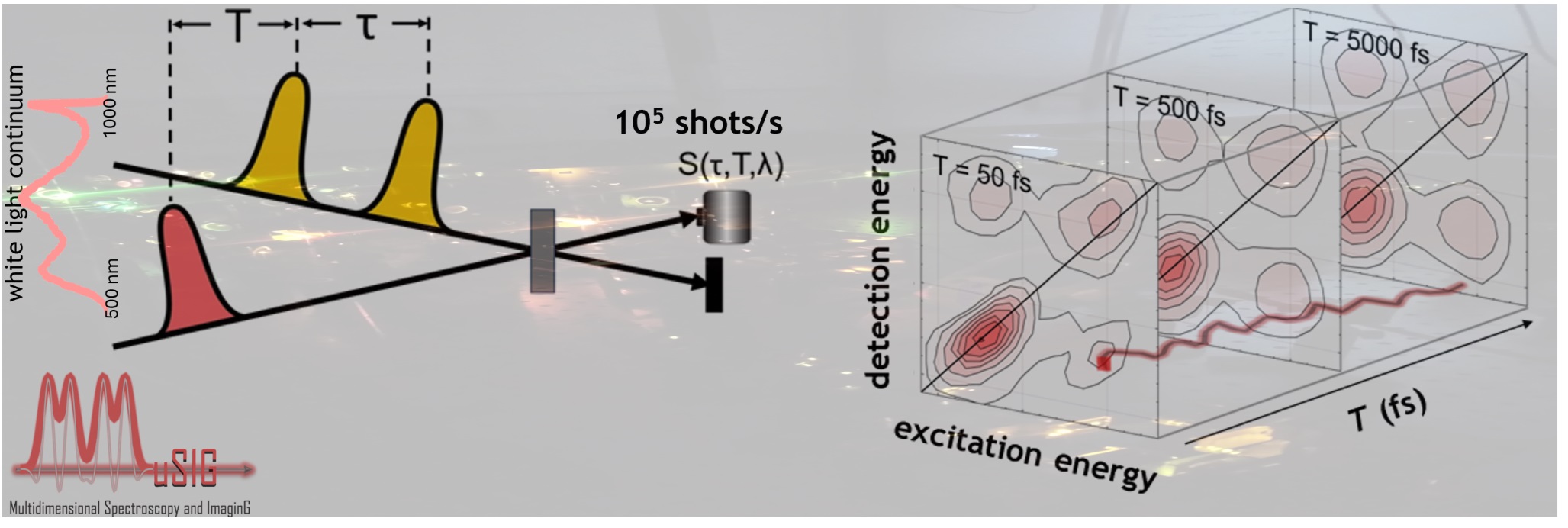Exciting Everything Everywhere All At Once: A New Approach to Optical Spectroscopy at Femtosecond Timescales

Ultrafast phenomena in the condensed phase refer to motions of electrons and nuclei occurring at a few tens of femtoseconds (10-15 seconds) across a broad range of light wavelengths. Such phenomena are seen in the first steps of mammalian vision and photosynthesis, phase transitions in quantum materials, and charge generation in emerging photovoltaic materials. Probing them requires specialised optical spectrometers that simultaneously provide fast time resolution at all possible wavelengths with microscopic spatial resolution, and the ability to unambiguously decongest overlapping spectral features.
These phenomena are typically probed using a combination of two beams, a pump that sends the system to an excited state and a probe that monitors the subsequent relaxation of the system, called the pump-probe approach. This is akin to initiating an unknown dance sequence, and watching it at controlled time intervals to reconstruct the entire sequence. The challenge here is that the camera needs to capture even the fastest sequences while ignoring background noise, and ensure that no individual dancer is missed. A neat way to address this challenge is by initiating the sequence in many different ways – with many different excitation energies – and then monitoring the resulting dance at different time intervals after excitation. This results in a snapshot 2D map that correlates the different excitation energies with detection energies. This specialised and now state-of-the-art approach is called multi-dimensional electronic spectroscopy (MDES).
So far the only reliable and efficient MDES approach depends on shaping the amplitude of light pulses using sound waves launched in a crystal. Such approaches are even available as commercial push-button spectrometers. However, they are complex and expensive, and their ability to watch all dancers at the fastest timescales is fundamentally limited by the acoustic velocity in the crystal.
Now writing in the Journal of Chemical Physics, Asha Thomas, Vivek Bhat and Vivek Tiwari from the Solid State and Structural Chemistry Unit (SSCU), IISc, report for the first time an optical spectrometer that works with conventional home-built optics and electronics, and yet provides superior sensitivity and throughput than the existing state-of-the-art.
The unique spectrometer allows unprecedented access to the fastest timescales along multiple spectral dimensions in several interesting systems such as organic photovoltaics and emerging quantum material platforms.
The approach is also scalable and works equally well at increasing laser pulse rates. This is an essential milestone technology for combining specialised time-resolved spectroscopy with a microscope, which is an overarching goal in the international spectroscopy community. The hope is that the work, now patented as well, spurs indigenous and internationally competitive innovation of optical spectrometers, which is almost non-existent.
This work has been recognised as an Editors’ Choice Feature Article in the Journal of Chemical Physics, reserved by editors for only the top 3% papers in the field.
REFERENCE: https://pubs.aip.org/aip/jcp/article/159/24/244202/2931951/Rapid-scan-white-light-two-dimensional-electronic
LAB WEBSITE: https://sites.google.com/view/musig/



